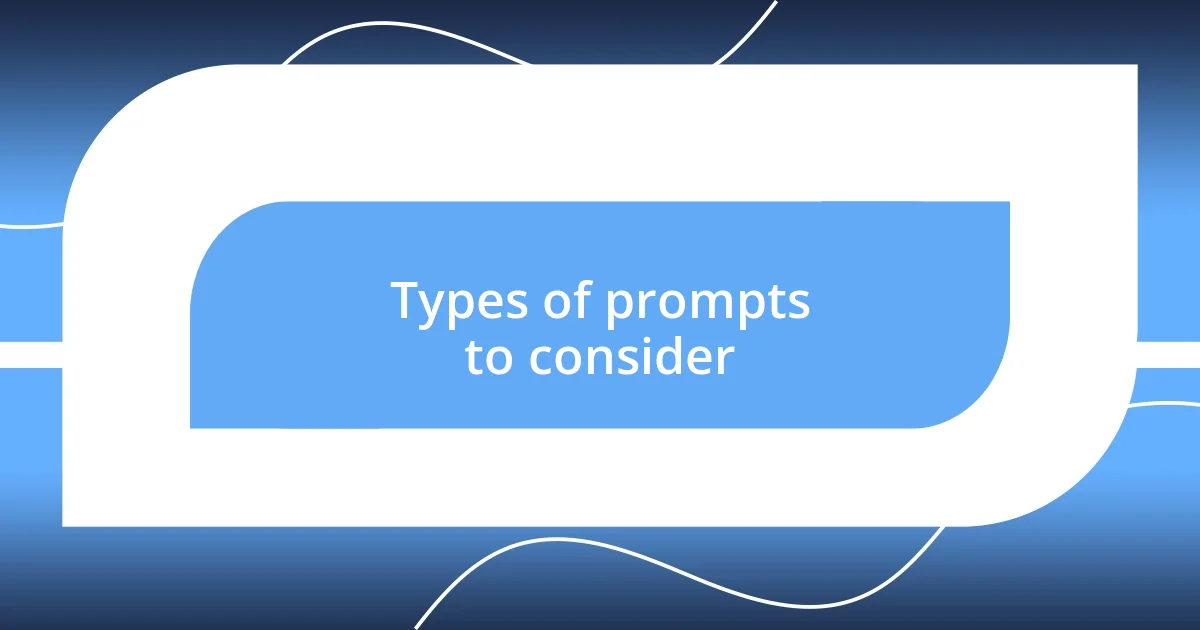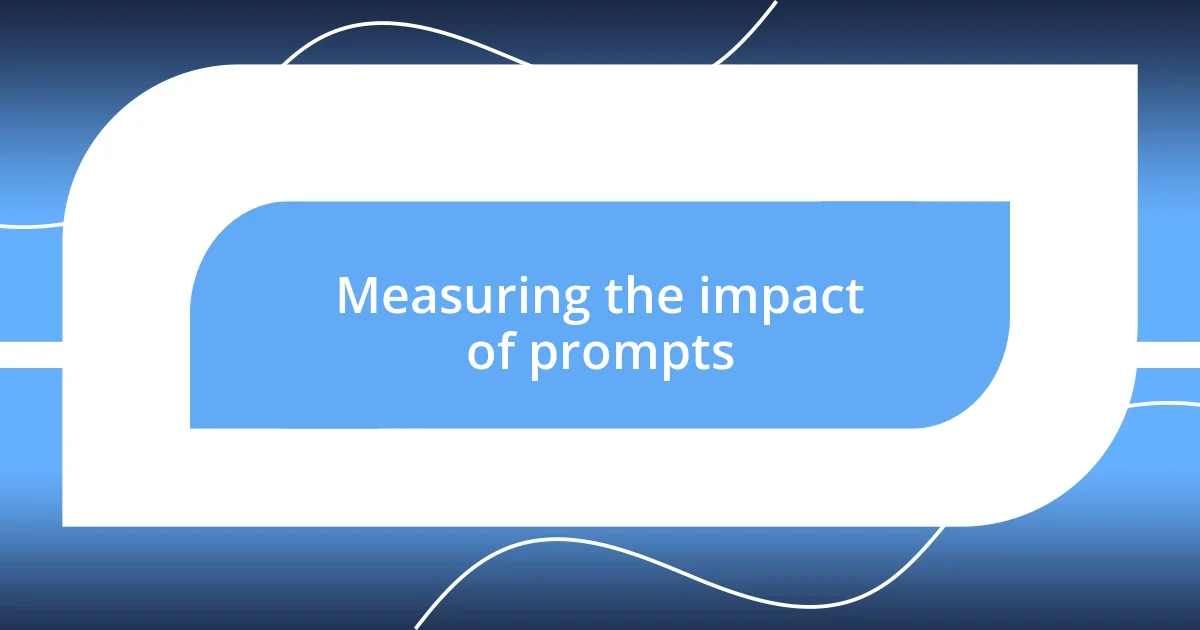Key takeaways:
- Prompts enhance creativity by breaking rigid thinking patterns and fostering unexpected connections, leading to new ideas.
- Different types of prompts serve unique purposes: open-ended prompts encourage expansive thinking, situational prompts enhance detail, and creative constraints foster focused innovation.
- Reflecting on prompt responses can lead to personal growth and clarity, while integrating techniques like personalization and sensory experiences can overcome creative blocks and boost productivity.

Understanding the role of prompts
Prompts serve as powerful catalysts for creativity, igniting thoughts and ideas that might otherwise remain dormant. I remember a time when I stared at a blank page, feeling overwhelmed. Then, a single question prompt flipped my mindset: “What would happen if I rewrote a classic story from the villain’s perspective?” Suddenly, the ideas flowed like an opened faucet.
The beauty of prompts lies in their ability to spark unexpected connections. Have you ever noticed how a simple phrase can take your thoughts in a completely new direction? Just last week, a prompt about “the significance of a forgotten object” led me to reflect on my grandmother’s old music box, which was a treasure trove of memories swirling with nostalgia and emotion. That moment transformed into an article that delved deep into the essence of memory itself.
When I engage with prompts, I find that they help me break free from rigid thinking patterns. Each prompt acts as a door into a world of possibilities. It’s almost like having a conversation with my inner self, encouraging exploration without judgment. In these moments, I often wonder: what if I allowed myself to play with ideas more often?

Types of prompts to consider
Different types of prompts can serve unique purposes, and I’ve found it essential to choose the right one depending on my creative needs. For example, open-ended prompts often invite expansive thinking, allowing my imagination to run wild. I once used an open-ended prompt: “What if animals could speak?” This led me to write a whimsical short story where my cat shared her thoughts on our daily antics, resulting in laughter and a deeper connection with my furry friend.
Conversely, situational prompts can ground your ideas by placing them in a specific context. I vividly recall a time when I responded to a prompt that defined a scene: “Describe a bustling marketplace.” This struck a chord, and I could almost hear the hustle and bustle as I conjured up vivid characters and sensory details. The prompt helped me tap into my memories of visiting local markets, full of vibrant sights and sounds, transforming my writing into a rich tapestry of experiences.
Finally, creative constraints can be surprisingly liberating. When I challenged myself to write a poem using only five words, I was amazed by the clarity it forced. It made me strip away the excess and focus on what truly mattered. There’s something exhilarating about working within boundaries that can often lead to unexpected inspiration.
| Type of Prompt | Description |
|---|---|
| Open-Ended Prompts | Invites expansive thinking and creativity. |
| Situational Prompts | Grounds ideas in specific contexts, enhancing detail. |
| Creative Constraints | Encourages focused and innovative thinking within boundaries. |

How to use prompts effectively
While using prompts, I’ve realized that setting the right environment plays a crucial role in how effective they can be. I often find that a quiet space, away from distractions, allows my mind to fully engage with the prompt. For instance, the other day, I nestled into my favorite reading nook with a cup of tea and a beautiful journal. When I read the prompt, “Write about a moment that changed your perspective,” it felt like the world around me faded. That space allowed my thoughts to flow freely; I penned down a profound memory of a hiking trip that changed how I viewed challenges.
To maximize the effectiveness of prompts, I’ve developed a few strategies that consistently help me dive deeper. Consider these tips:
– Personalize your prompts: Tailor them to your experiences, making them resonate more.
– Limit your time: Set a timer for 10-15 minutes to encourage rapid idea generation and prevent overthinking.
– Reflect on your responses: After answering a prompt, review what you’ve created, ensuring to capture the most powerful insights.
– Mix different types of prompts: Use a combination of open-ended, situational, and even constraints to keep your ideas fresh and dynamic.
– Write without judgment: Allow your thoughts to flow, knowing it’s okay if not every idea is perfect.
By integrating these techniques, I find that my creativity flourishes, often leading me to unexpected discoveries.

Techniques for refining prompts
Refining prompts is an art I’ve come to embrace over time. One technique that works for me is rephrasing prompts to evoke stronger emotions or memories. For instance, when I transformed a prompt from “Write about a childhood dream” to “Recall your most magical childhood dream and what it meant to you,” it shifted the focus. This subtle change deepened my connection to the topic, leading to richer storytelling and a surge of nostalgia.
Another method I often employ is layering prompts. Instead of tackling a single prompt, I combine two or more. When I faced a creative block, I merged “Describe your favorite place” with “In that place, create a vivid character.” This approach opened floodgates of inspiration, allowing me to visualize not only the setting but also the person’s quirks and backstory. Have you ever mixed prompts? I find that blending perspective can spark ideas I never anticipated.
I also play with lengths and formats. For example, if a prompt suggests writing a paragraph, I might challenge myself to a haiku instead. This forces me to distill my thoughts and reveals ideas hidden beneath the surface. Recently, I responded to a prompt asking for a short story and ended up crafting a two-line poem that perfectly encapsulated the emotion I wanted to convey. It made me realize that sometimes less is more, and that a shift in format can yield unexpectedly profound insights.

Overcoming creative blocks with prompts
When I hit a creative block, prompts can be my ultimate lifeline. Just last week, I was feeling stuck while trying to develop a new article. I grabbed a prompt that said, “What would your childhood self think of your current life?” I paused for a moment, then began to write. As childhood memories flowed back, I felt a mix of nostalgia and warmth, and suddenly, my ideas blossomed. It was as if my younger self had a unique perspective that brought clarity to my adult challenges.
Another technique I use is to focus on sensory experiences. I once encountered a prompt that asked me to “Describe your favorite smell and why it’s significant.” Instinctively, I thought of my grandmother’s kitchen filled with the rich aroma of freshly baked cookies. The memories evoked were so vivid that it broke down my creative barriers. I realized that tapping into emotions associated with sensory memories often unearths powerful insights that I can translate into my writing.
I sometimes wonder how other creatives respond to prompts. Do they find the same connection? I regularly delve into prompts that challenge my comfort zone, such as “Write about a fear you overcame.” The discomfort of addressing my fears has often transformed into a source of motivation and inspiration. I find it fascinating how confronting these obstacles can lead to a surge of creativity, allowing me to emerge with fresh ideas that resonate deeply.

Case studies of successful prompts
In my exploration of prompts, I’ve had some eye-opening experiences that really demonstrate their potential. I remember a specific instance where I used the prompt, “What would happen if you had the chance to meet your hero?” It encouraged me to dive into my admiration for a childhood author, and as I wrote, I not only reflected on his work but also discovered my passion for storytelling rooted in his influence. It was a powerful reminder of how prompts can bridge the gap between inspiration and personal growth.
Another compelling case study occurred when I stumbled upon a prompt that simply asked, “Write a letter to your future self.” Initially, it felt daunting, but the act of addressing my future ambitions unlocked my aspirations. I poured out my hopes and dreams, and in just a few moments, I saw a clearer path forward. Who knew that the act of communicating with my future self could clarify my current goals so effectively? That simple prompt made me realize how our future can motivate our present actions in unexpected ways.
Sometimes, I find that using prompts to revisit past experiences can yield surprising results. For example, a prompt that urged me to “Choose a moment you were proud of and recount it in detail” compelled me to relive an experience where I helped a friend overcome a challenge. As I detailed that moment, I felt a rush of pride and gratitude. I began to understand that not only the outcome matters, but the journey we take along the way. By reflecting on these moments, I can ignite new ideas and add depth to my writing. Isn’t it fascinating how looking back can inform our future creativity?

Measuring the impact of prompts
Measuring the impact of prompts is something I take seriously, as they can lead to surprising revelations in my creative process. For instance, after using a prompt about my greatest failure, I noticed how cathartic it felt to put those feelings into words. Reflecting on that experience allowed me to understand how much I had grown, transforming my perception of setbacks into stepping stones for future success.
I like to think of prompts as tools that provide measurable outcomes in my writing journey. After a particularly challenging experience with a prompt related to self-discovery, I noticed an uptick in my productivity and enthusiasm. Isn’t it interesting how an external nudge can drive internal awareness? I began tracking my thoughts post-prompt and was able to pinpoint specific ideas that flourished, demonstrating how prompts not only spark inspiration but also help gauge my growth over time.
To assess the impact, I often revisit my writings from prompt sessions to see how they influenced subsequent projects. One time, revisiting a prompt on vulnerability, I unearthed a treasure trove of emotions that shaped my next article. Seeing these connections reinforced my belief that prompts not only ignite creativity but also offer measurable insights into my personal development as a writer. How often do we truly assess what ignites our passion and fuels our creativity?














